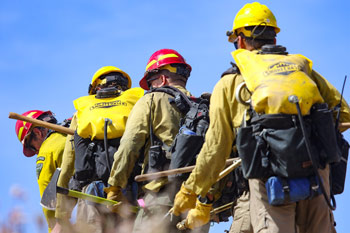Click Here for California Fires
August 20, 2024 - As of this morning, 59 large active wildfires are being managed with full suppression strategies nationwide. Current wildfires have burned 2,249,946 acres.  21,,812 wildland firefighters and support personnel are assigned to wildfires, including 20 complex and 3 Type 1 incident management teams, 501 crews, 926 engines, 126 helicopters, and four Modular Airborne Fire Fighting Systems, or MAFFS.
21,,812 wildland firefighters and support personnel are assigned to wildfires, including 20 complex and 3 Type 1 incident management teams, 501 crews, 926 engines, 126 helicopters, and four Modular Airborne Fire Fighting Systems, or MAFFS.
Since January 1, 31,043 wildfires have burned 5.4 million acres. More than 26,600 wildfires were started by people and they burned 3.3 million acres. Lightning ignited about 4,300 wildfires, burning nearly 2.1 million acres.
Drone incursions over wildfires continue to rise. So far this year, 16 incursions were reported and air operations were shut down eight times. When firefighting aircraft are grounded because of an unauthorized drone, our personnel lose access to a valuable resource which can affect the safety and efficiency of the overall suppression efforts. Flying a drone near a wildfire puts lives at risk. Please Know Before You Fly and help keep our wildland firefighters in the air and on the ground safe.
Sixty fireline management personnel from Australia and New Zealand are assigned to support large fires in the Northwest Area. For more information about the mobilization of wildland firefighters from Australia and New Zealand visit the international support page.
Two hundred forty-five soldiers from the 14th Brigade Engineer Battalion and the 1st Battalion, 17th Infantry Regiment based out of Joint Base Lewis McChord (JBLM) are deployed in support of wildland fire operations on the Boise National Forest. NIMO (Team 2) is assigned to support the military contingent. To learn more about military mobilizations, visit the military support page.
There are fuels and fire behavior advisories in place for Northwest Texas, Colorado's Front Range and Eastern Wyoming, Southwest Oregon, the region east of the Cascades in Oregon and Washington, and California. Residents, travelers, or workers on their way to any of these states should be advised and familiarize themselves with the elevated risks.
Note: The current reporting from source data for year-to-date figures appears to be underreporting fire acreage in some geographic areas affecting the overall national statistics. Given the very high tempo and scale of national current fire activity, there will be delays in reconciling, especially from areas with large fires and dynamic fire activity. Adjustments may occur as the accuracy of fire locations, mapping and final fire reporting is reconciled.
Southwest flow is forecast to increase along the West Coast with breezy west to southwesterly winds continuing from the Columbia Basin into much of central and southern Idaho and Nevada. The winds will be strongest along the Sierra Front and eastern Nevada where relative humidity will fall to 3-15%, while humitidy will be higher at 15-30% with temperatures about 10 degrees cooler than Monday in the Columbia Basin. Moderated conditions will continue west of the Cascade and Sierra Crests with temperatures near to below normal. The monsoon will continue to weaken in the Four Corners with isolated mixed wet and dry thunderstorms forecast in Arizona and much of the Rockies, with the greatest threat for new ignitions in western Montana and much of Wyoming. Temperatures will cool slightly in the southern Plains but remain above normal amid relative humidity of 10- 25%. Cooler temperatures closer to normal are forecast in the Lower Mississippi Valley and Deep South, but anomalously dry air is also forecast, as relative humidity falls to 25-35% in the afternoon. Meanwhile, a cool but dry airmass will spread across the Great Lakes, Ohio Valley, and Northeast, while seasonably cool conditions continue in Alaska.
| Number of new large fires or emergency response * New fires are identified with an asterisk |
3 | States currently reporting large fires: |
| Total number of active large fires Total does not include individual fires within complexes. |
59 | |
| Acres from active fires | 2,249,946 | |
| Fires contained | 5 |
Year-to-date statistics
| 2024 (1/1/24-8/20/24) | Fires: 31,043 | Acres: 5,415,842 |
| 2023 (1/1/23-8/20/23) | Fires: 36,375 | Acres: 1,760,125 |
| 2022 (1/1/22-8/20/22) | Fires: 0 | Acres: 5,983,909 |
| 2021 (1/1/21-8/20/21) | Fires: 41,043 | Acres: 4,384,403 |
| 2020 (1/1/20-8/20/20) | Fires: 37,824 | Acres: 2,919,926 |
| 2019 (1/1/19-8/20/19) | Fires: 31,051 | Acres: 3,791,108 |
| 2018 (1/1/18-8/20/18) | Fires: 41,419 | Acres: 5,922,604 |
| 2017 (1/1/17-8/20/17) | Fires: 42,809 | Acres: 6,451,305 |
| 2016 (1/1/16-8/20/16) | Fires: 38,592 | Acres: 4,133,549 |
| 2015 (1/1/15-8/20/15) | Fires: 41,525 | Acres: 7,293,666 |
| 2014 (1/1/14-8/20/14) | Fires: 37,119 | Acres: 2,630,176 |
10-year average Year-to-Date
| 2014-2023 | Fires: 38,940 | Acres: 4,487,582 |
Source: NIFC








